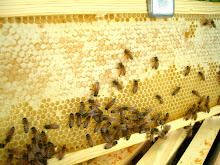The unusually warm temperatures for this time of year have generated a lot of early activity among honeybees in many parts of the country. Here in Atlanta, trees and flowers bloomed early, the pollen count has reached extreme levels, and swarming began in late February.
My Apollo bees swarmed a couple of weeks ago. They "buzz level" was audible for a few days beforehand and bearding happened the day before. The swarm made its way to the pine tree limb in my neighbor's yard, a popular spot for last year's swarms. Later that same day, the bees came back down into my yard and clustered near the ground on some scrub shrubbery. My attempt to collect them from the ground failed miserably (including taking a couple of stings to my right leg). The next afternoon, the bees were back up in the pine tree and later took off for parts unknown.
I have since learned how to collect a swarm from the ground via a YouTube video and some words of wisdom from Jerry Wallace of the Metro Atlanta Beekeepers. In a couple of weeks, my friend Drea and I are driving up to Lafayette, Ga. to visit Pigeon Mountain Trading Company, which has quite a cache of beekeeping supplies. I plan on buying a swarm trap and some bee lure (pheromone) to see if I can attract some bees to fill my empty Sweet Beezuz hive.
This morning's inspection was really interesting, probably generating more questions than answers. First, the Rocky hive: I removed the top shallow super when I saw that the wax inserts were all coming out of their frames. It would be almost impossible for the bees to shore them up enough to store honey. I'll fix them and put the box back on next time. A look into the next super showed that the Rocky girls are busily making honey there — no sign of laying activity, so I hope to harvest this box in a couple of months. I pulled out the sticky board from below and saw something interesting — a bunch of dark "pods." I can't tell if these are just propolis or if the bees have entombed some kind of insect. I set the board aside to look at later.
Now, the Apollo hive: there were bees in the top shallow super and the frames there were in good shape. But when I went down into the next box, I got a little shock. The Apollo girls are storing honey around the edges of the frames, but there were a LOT of supersedure cells (emergency queen cells) on the middles frames. Does this mean the hive is without a queen or is it just an indication of a lot of future swarm activity? So there's my homework. When I pulled out the sticky board, dozens of earwigs came with it. Ugh. I am leaving these boards out of the hives for now — most insects that the bees can't take care of themselves will fall onto the screened bottom board and not cause problems.
I removed the plastic feeders from the entrance of both hives. I found wax moth larvae at the Apollo hive entrance, which I quickly destroyed. The beetle traps seem to be working well in both hives. Next time, I must remember to take the camera and document with photos!
Here's a video of my first swarm of the season.
Subscribe to:
Post Comments (Atom)

I know you have done a lot since this posting -- going to N. Georgia, etc. for supplies and possibly new bees for Sweet Beezus, etc. Were you able to "recruit" some new ones for that empty hive? I am also surprised at how many other insects are involved with the hives -- freeloaders!!!
ReplyDelete